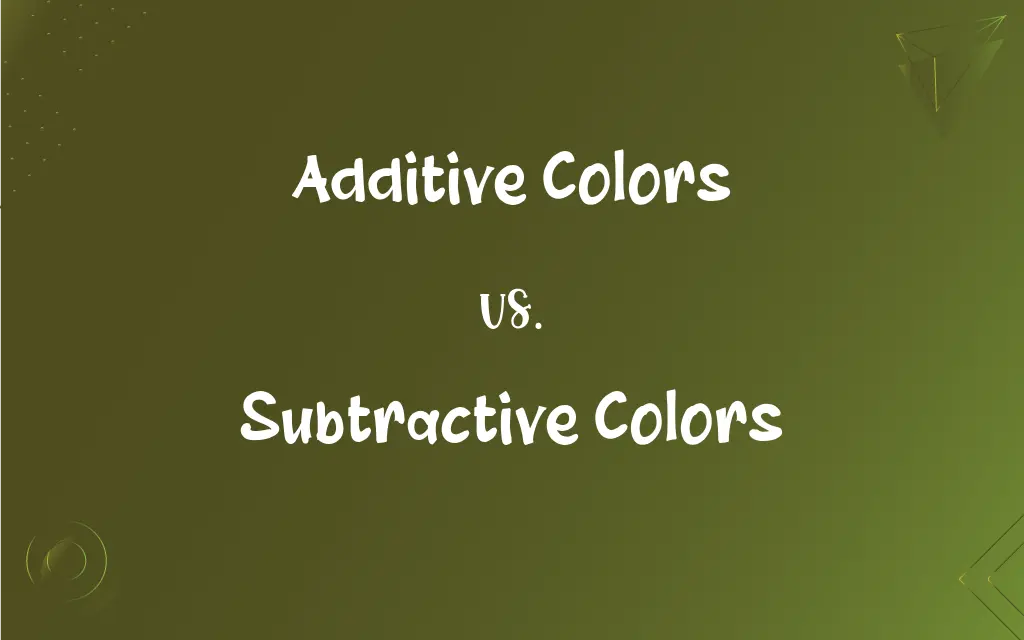Additive Colors vs. Subtractive Colors: What's the Difference?
Edited by Aimie Carlson || By Harlon Moss || Updated on October 27, 2023
Additive colors combine light to create colors; subtractive colors mix pigments, absorbing light.

Key Differences
Additive colors refer to the system where colors are produced by mixing different hues of light, primarily red, green, and blue. When these primary lights combine, they form secondary colors. On the contrary, subtractive colors deal with the reflection and absorption of light by colored pigments or dyes. This system relies mainly on three primary colors: cyan, magenta, and yellow.
In the realm of additive colors, when you mix all primary light colors together (red, green, blue), the result is white light. This principle is the foundation for devices like televisions and computer screens. However, in the subtractive colors system, combining all primary colors (cyan, magenta, yellow) typically results in black or a muddy brown, since each color absorbs (subtracts) certain wavelengths of light.
Additive colors are named so because they "add" wavelengths of light to black, starting with no colors and achieving full brightness when all are combined. Devices that emit light, such as digital displays, utilize this principle. Conversely, subtractive colors work by "subtracting" brightness from white, meaning they remove certain wavelengths from light by absorbing them, as seen in paints and inks.
Human vision is inherently designed to perceive additive colors. Our eyes contain photoreceptors sensitive to red, green, or blue wavelengths, making the RGB system a natural fit for digital displays and lighting. In contrast, most physical media, like paper and fabrics, use subtractive colors since they don't emit light but rather reflect it. Mixing pigments in these media results in colors based on the parts of the light spectrum they reflect.
It's fascinating to observe the interplay between additive and subtractive color principles in daily life. For instance, a digital design on a screen (using additive colors) might appear differently when printed on paper (using subtractive colors). This distinction is crucial for professionals in fields like graphic design and photography to understand, ensuring consistency and accuracy in color representation across mediums.
ADVERTISEMENT
Comparison Chart
Medium
Light sources
Pigments, inks
Starting Point
Black in darkness
White in light
Primary Colors
Red, green, blue (RGB)
Cyan, magenta, yellow (CMY)
Color Mixing Result
White when combined
Black when combined
Brightness
Increased with more light
Decreased with more pigment
ADVERTISEMENT
Usage
Screens, digital displays
Painting, printing
Color Creation
By adding light
By absorbing light
Spectrum
Wide range of visible light
Limited by pigment properties
Application
Light-based technology
Traditional art, print media
Interaction
Colors add to each other
Colors subtract from each other
Additive Colors and Subtractive Colors Definitions
Additive Colors
A method of creating color by adding light.
Projectors use additive colors to display images.
Subtractive Colors
Color model based on pigment mixing.
Subtractive colors are used in traditional painting.
Additive Colors
Color model involving light addition.
Televisions use additive colors for their displays.
Subtractive Colors
Technique used in painting and print media.
Artists often mix paints using subtractive colors.
Additive Colors
Technique used in digital media and screens.
Smartphone displays rely on additive colors.
Subtractive Colors
Mixing of colored pigments to form new colors.
Printers utilize subtractive colors for inkjet printing.
Additive Colors
A color system where light colors combine to form white.
Additive colors are fundamental in digital art creation.
Subtractive Colors
A color system where pigment colors combine to form black.
Subtractive colors are essential in color printing.
Additive Colors
Mixing of colored light to form new colors.
Stage lighting often employs additive colors for effects.
Subtractive Colors
A method of creating color by absorbing light.
Subtractive colors are at play when mixing dyes for fabrics.
FAQs
How do additive colors work?
They work by adding light to create new colors.
What are the primary colors for additive colors?
Red, green, and blue.
How do subtractive colors work?
They work by absorbing some wavelengths of light.
What are additive colors?
Colors created by mixing different light sources.
What are subtractive colors?
Colors created by mixing pigments or dyes.
Can additive colors create black?
No, the absence of light results in black.
Can subtractive colors create white?
No, they start with white and can only subtract from it.
Why do monitors use additive colors?
Because they emit light, making additive colors ideal.
Are additive colors more vibrant?
Yes, they can produce a wider range of vivid colors.
Where are additive colors commonly used?
In digital displays and lighting.
What happens when you mix all subtractive primary colors?
You get black or a dark brown color.
Is RGB related to additive or subtractive colors?
RGB is related to additive colors.
Is CMYK related to additive or subtractive colors?
CMYK is related to subtractive colors.
Do printers use additive colors?
No, printers use subtractive colors.
What are the primary colors for subtractive colors?
Cyan, magenta, and yellow.
Where are subtractive colors commonly used?
In painting, printing, and dyeing.
What happens when you mix all additive primary colors?
You get white light.
Are subtractive colors more limited?
Yes, due to the limitations of pigments.
Do artists use additive colors?
Yes, especially those working with digital media.
Can the human eye perceive more additive or subtractive colors?
The human eye can perceive a wider range of additive colors.
About Author
Written by
Harlon MossHarlon is a seasoned quality moderator and accomplished content writer for Difference Wiki. An alumnus of the prestigious University of California, he earned his degree in Computer Science. Leveraging his academic background, Harlon brings a meticulous and informed perspective to his work, ensuring content accuracy and excellence.
Edited by
Aimie CarlsonAimie Carlson, holding a master's degree in English literature, is a fervent English language enthusiast. She lends her writing talents to Difference Wiki, a prominent website that specializes in comparisons, offering readers insightful analyses that both captivate and inform.































































